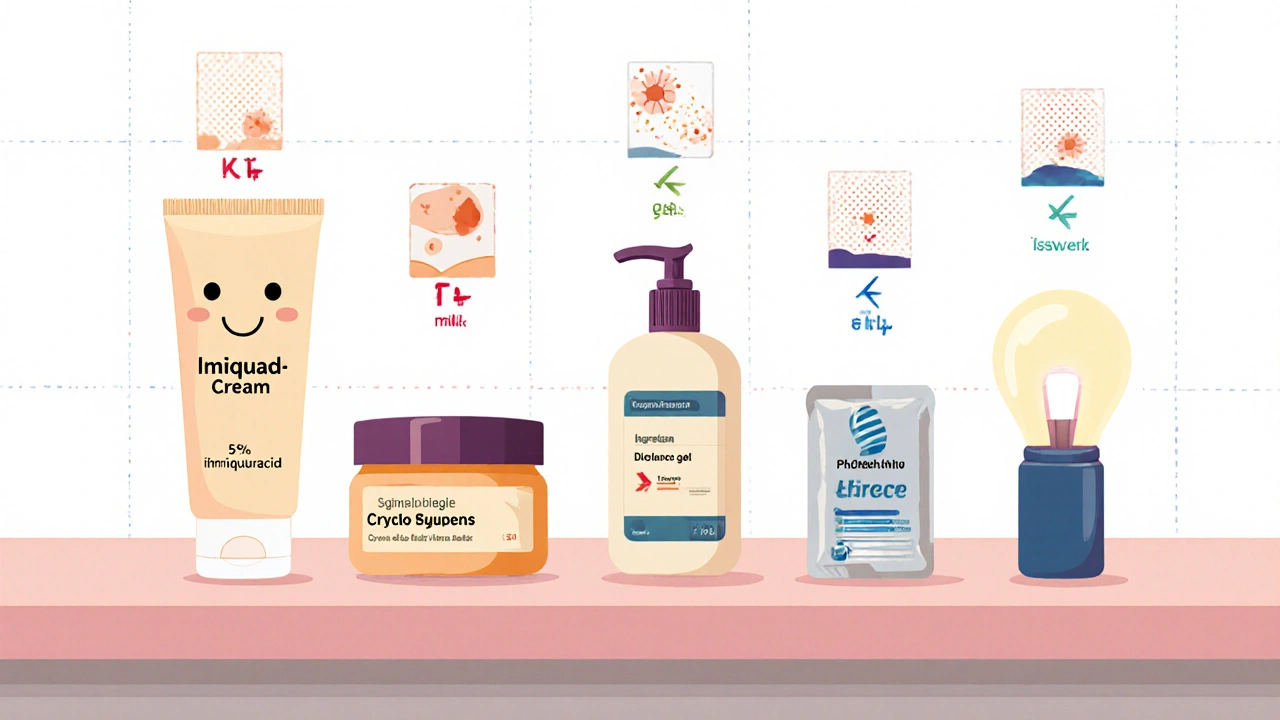When dealing with actinic keratosis treatment, a set of medical approaches that target precancerous skin lesions caused by long‑term sun exposure. Also known as AK therapy, it aims to remove abnormal cells and lower skin cancer risk. You’ll find that the right choice depends on lesion size, location, and how quickly you want results.
One common method is cryotherapy, quick freezing of lesions with liquid nitrogen to destroy abnormal tissue. Cryotherapy is fast, usually takes just a few minutes, and leaves a small scab that falls off in a week. Another option is photodynamic therapy, use of a light‑activated drug that targets cancer‑precursor cells after exposure to a specific wavelength of light. PDT works well for larger or multiple lesions and often results in smoother skin after healing. A third, often prescribed, approach is topical 5‑fluorouracil, a chemotherapy cream that erodes abnormal cells over a two‑week course. This cream can cause redness and peeling, but it treats the whole area, reducing the chance of missed spots.
First, think about how many lesions you have. A single spot may be best suited for cryotherapy, while dozens might call for topical 5‑fluorouracil or photodynamic therapy. Second, consider your skin type and tolerance for side effects. Cryotherapy usually causes mild discomfort, but the area heals quickly. Topical 5‑fluorouracil can be messy and may require you to stay home for a few days. Photodynamic therapy can cause sensitivity to sunlight for several weeks, so you’ll need diligent sun protection afterward.
Insurance coverage also plays a role. Cryotherapy is often covered because it’s quick and inexpensive. PDT and topical chemotherapies sometimes need prior authorization, especially if you’re using a brand‑name formulation. Talk to your dermatologist about what the out‑of‑pocket cost will be.
Another factor is the cosmetic outcome you want. Cryotherapy may leave a small pigment change, while topical 5‑fluorouracil can cause temporary discoloration that fades over months. Photodynamic therapy tends to produce the most even skin tone after healing, making it popular for facial lesions.
Finally, keep in mind the goal of actinic keratosis treatment—preventing progression to squamous cell carcinoma. All three methods have been shown to reduce that risk, but regular follow‑up is essential. Your doctor may schedule skin checks every six months to catch any new lesions early.
In practice, many patients combine approaches. For example, a dermatologist might freeze a stubborn spot with cryotherapy and then prescribe a short course of 5‑fluorouracil for surrounding areas. This hybrid strategy maximizes clearance while minimizing downtime.
Whatever route you choose, preparation matters. Clean the area gently before any procedure, avoid tanning beds, and use a broad‑spectrum sunscreen with at least SPF 30 daily. These steps support healing and help keep new AKs from forming.
Below you’ll find a curated list of articles that dive deeper into each option, compare side‑effect profiles, and offer practical tips for after‑care. Whether you’re looking for a quick fix or a long‑term plan, the resources here will help you decide the best path forward.
Posted by
Jenny Garner
6 Comments

A comprehensive side‑by‑side look at Imiquad cream versus other topical treatments, covering how they work, side‑effects, costs and when each option is best.
read more